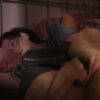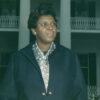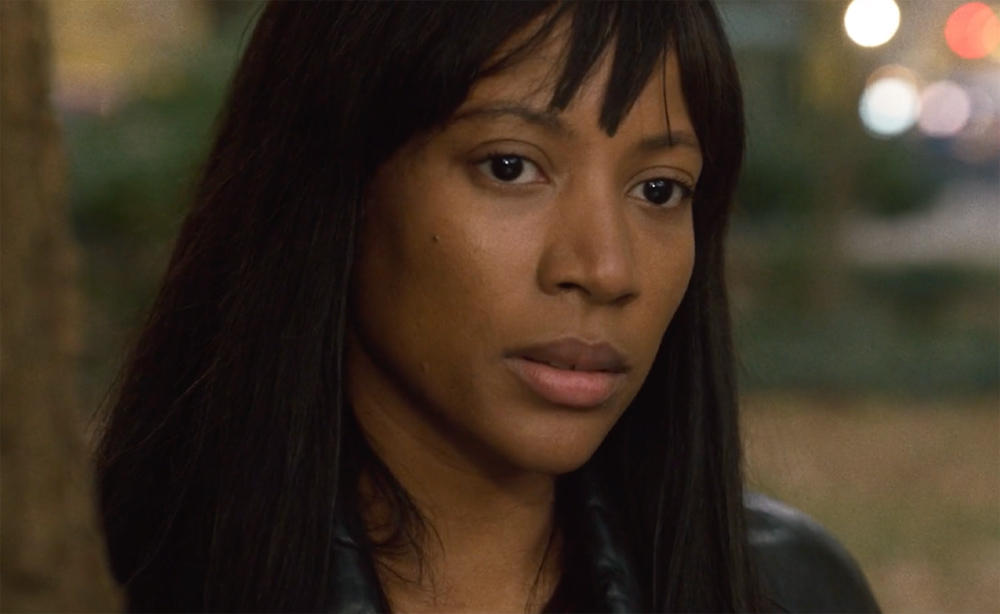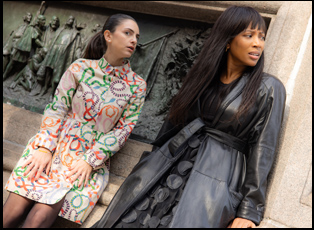At first, it could seem like it’s simply a stranger catching the eye of Suzette (Natalie Paul) in the street as she looks on from a diner on the Upper West Side where she’s having a coffee with a friend in “New York Day Women” as a woman in a glorious green-and-gold floral print can hardly be missed at an intersection. However, after excusing herself from the table, it becomes obvious the two have a deeper connection as Suzette puts on sunglasses to follow the well-dressed woman incognito as she browses department store windows and grabs a hot dog from a halal cart, revealing that this is the first time she’s ever seen her mother in this part of the city, scrambling to remember the last time she ever left her apartment in the Haitian American enclave of East Flatbush.
The jarring moment of Suzette seeing her mother Josephine (Kathleen Tureene) in a different cultural context opens up an entirely new perspective on her in Fredgy Noël’s amusing and poignant short, which itself playfully questions all the well-known New York-set comedies that have come before when placing proud Black women at the center. In adapting Edwidge Danticat’s short story for the screen, Noël subverts the nostalgia-tinged narration you might hear in “Manhattan” or “Sex and the City” to have multiple meanings as Suzette wistfully recalls the mother she grew up with, hand-plucking chicken for dinner and putting curls in her hair. However, Josephine’s devotion to her daughter created a blind spot for Suzette of ever seeing her as anything but her caretaker and as fond memories float through her head of the person she knew, observing Josephine from afar independently going about a day on her own has all the excitement of discovering someone new.
Although Noël will mischievously pull the lens in and out to capture the hustle and bustle of New York, the unflinching focus on the mother-daughter relationship allows for a far larger tale than the film’s nine-minute runtime would seem to allow for as Suzette stumbles into an inner world of her mother’s that she never knew and giving glimpses into the life she shared with Josephine, it’s likely “New York Day Women” will have the same effect on audiences from outside the Haitian American community when Noël lovingly captures its rituals and routines. With the film making a splash this week in its hometown at Tribeca, Noël spoke about how she could pack so much into the film, the benefits of having a common language with the cast and making the best of the unexpected that occurred during the production.
When I’d read Edwidge Danticat’s anthology of short stories, they really stuck with me because her portrayal of the first-generation Haitian American experience was just so unique and spoke to me because there were just so many different variations of it. Years later, I was at Provincetown International Film Festival and a programmer there was Haitian and when I [said] I love Edwidge, she said, “I know her, do you want me to put you in touch?” And I said yes. I’ve never been so bold as to say something like that, but I did, and she looked at some of my work and I asked her if I could just adapt one of her short stories and she said, “Choose one.” “New York Day Woman” just really stuck with me. I loved the playfulness I could find in the story, just from the back and forth of it, so she said “Yes” [to adapting it] and here we are.
Was the structure naturally there or did it take time to figure out how to bring to the screen?
Everything the mother says is taken from the short story and the narration is a combination of my writing and Edwidge’s writing. I brought in a character — the work colleague [because] I wanted to show an aspect of [Suzette’s] life in the city that was very different from Brooklyn. I really wanted Brooklyn to be about her and her mother. And when you’re adapting work and the work is already perfect, you get to really see how you can add to it, so I read the words and I visualized the place where she would be giving her daughter this advice, whether it was you know in her bedroom or walking down a street or on her porch and the porch was so unique to Brooklyn immigrant experiences. I know we usually see people on stoops in New York, but I really wanted to say there’s this part of it too and and and there are a lot of people who can relate to it. I just dreamt about what time of day would I want to hear this line or what would she be doing while she was saying these words and that’s how that came about.
You’re able to draw a stark visual contrast quite efficiently. What went into figuring out presenting these different parts of the city?
Color, color, color. The Brooklyn world is just so colorful and Island [style]. The Manhattan world, they’re all black — she had to have the black leather trench coat and when you see that on her in Brooklyn, I wanted it to feel a little out of place. So I thought of color a lot, but then with her friend I wanted her to exhibit a little bit of color too [where] it’s a little bit more contained with dots of reds and greens. I love Manhattan and I knew that whatever we got that day [we were filming] was going to depict Manhattan as in Manhattan should be depicted and I knew whatever we got in Brooklyn when we did the exteriors was going to be very different and very colorful, so that was just more of the city doing its thing, not me too much.
But [for] the interiors, I was thinking about growing up. I’m from the Maryland/DC area and we would come up to New York on summers and spend time with family in Brooklyn. My great-aunt who passed away last year lived there all her life. I remember how they had a whole house in a small space and there were just memories everywhere and that memory was always going to be colorful. It was always going to have some island specificity to it, whether it’s with florals or hand-caught chickens. I speak Creole fluently, so I knew that once I got there, the community would support me and it was a natural transition to just highlight the beautiful scenery and the people there.
How did you find your two leads?
A friend of mine referred Natalie Paul to me and we were supposed to work on something years ago. She had a baby and was just coming back into acting again, so with motherhood [as a theme], I thought this will be a great film for her and I needed Haitian actors in it, so she was gracious enough to read the script and just be down to shoot. But the mother was difficult. I could not find that character. I did a lot of research and there aren’t a lot of Haitian actresses of a certain age in New York. We’re lucky for [the amount there are], but it’s still not a lot and [Kathleen Turrene was] my friend’s mom. I saw her Instagram and [told my friend], “I think she’d be great for this role.” Then she asked her and [Kathleen] said, “Okay, what days do you need me.” It was very casual and she was such a natural. I got to direct them in Creole because there were certain things you can’t explain [in English], sentiments that only that language can give you, especially for telling the story I have to. I knew that [Kathleen] had three daughters and I knew that they lived with her and all of them are of a certain age, so I said, “Say this line to this daughter, and say this line to that daughter,” so I could speak to her in a natural kind of way and then I had [Natalie] the actress with the background [in acting] supporting her, so we used the language and the relationships that I had with her kids to really help guide her through it.
Was there anything you might not have anticipated once the performances might’ve started taking on a life of its own?
The film is about observation, so every time we did a take, I was watching from the daughter’s perspective and then I was watching from the mother’s perspective. There’s a lot of unspoken behavior that is found in Haitian tradition where [something like] an exhale means a million different things, so being able to catch them do that with each other, especially since they didn’t know each other, [was exciting]. Then I started looking at them and they actually looked like they could be related, so that mother-daughter relationship just opened up in front of me and I never pushed that on them, but I know that they felt that. They really created that dynamic and I think it’s why the film plays as well as it does.
When it is a film so rooted in observation, how did you develop a camera language with those fun zooms?
[My director of photography] Sarah Greenbaum is amazing and we walked all over Manhattan, thinking about what do we want to see and how do we want this captured? I said it’s a dance. We have to flow with with her and and that’s the only way this is going to work. The zoom is my favorite technique. The piece calls for it because it has to be intentional and there’s humor in it, so when we have her friend coming in [to the Westside Diner], it’s like “Who’s that?” It feels quirky and light and those are the kinds of films I like. I want it grounded [where] it’s true and authentic, but it’s light and delightful, so I wanted that kind of camera movement too.Did you shoot in Manhattan or Flatbush first?
We did Manhattan first and the diner scene that was our first. And I’ll tell you, the woman who’s on the bus stop was not the woman who I had cast. Someone else [had been cast] and she was running two hours late and I was losing light, so [the scene] wasn’t going to make any sense and my amazing [assistant director] Kai Hartman just went out to the streets and looked for any middle-aged Black woman and said “can you just sit down?” And that woman sat down, she let me [film the scene] three times and by the third time, she was like “I have to go.” But we finally figured it out and that is such an important part of the film. I see her every now and then on the Upper West Side and I’m like, “Do you know that you are in Tribeca Film Festival?” She was just so down-to-earth and just wanted to help out. Then the second day, we did all of the Manhattan, running around Columbus Circle and Central Park, and then the third day, we did all of the interiors for Brooklyn and then we had a half a day where we did the exterior shots.
Unbelievable. The score is also an integral part to pulling off the twist when it dramatically changes tones. What was it like putting music on this?
The jazz score of New York is something that sticks with me from the ’90s. I remember that’s how I would frame New York. It would just be some kind of staccato type jazz and I wanted that to be the base, but Leyla McCalla, the singer [who comes on over the end credits], I just love her music and the rhythm, the folklore and the words [of that song] and I just knew “This is this has to be in the movie. This has to ground us.” So finding this balance between those two was a lot of fun. I just like the moments especially when [Suzette’s] doing her hair at the end and then the jazz comes back in and it’s a reflection on everything, like the music bed for us to land.
What’s it like to start sharing this with audiences?
It’s so surreal. Every time I watch it, I get emotional and I edited it, so I’ve been with this film for a very long time. It’s seen a lot of different variations and to see how the audience is feeling and coming up to me and expressing things, it’s been a gift. I’m really humbled and I’m happy that I can showcase New York in all of its faces and this idea of seeing a person who you’ve looked up to be someone that has nothing to do with you and then having the city bring all of that out. I think people come here [to New York] for that — to figure out who they are and then sometimes if you’re living here, you don’t get that experience and I think this girl [Suzette] got that experience with that day, so it’s just been amazing.
“New York Day Woman” will screen at the Tribeca Festival on June 15th at 8:30 pm at Shorts Theater at Spring Studios.





